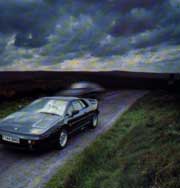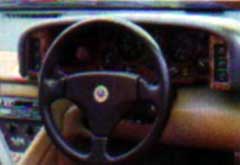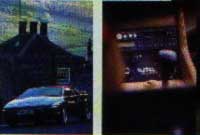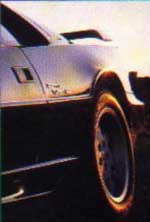

Green Machine
Fastlane
July 1989
The new Lotus Esprit Turbo
SE may have a 'green' engine, but with a 0-60 time of 4.6sec,
war has been declared against Porsche and Ferrari. We test it first.
You might have been forgiven for thinking that Lotus had already extracted all there was from their long-serving, four-cylinder engine. After all, 215bhp was a fair amount of horsepower, and the 153mph to which it was able to motivate the Esprit was a fair amount of speed. Where is the V8?
Undoubtedly over 200bhp is a lot from 2.2 litres, but with any new motivation still in the deepest recesses of the melting pot, Lotus needed something more to compliment last year's new smoothed-out, rounded-off Esprit body shape. It really needed to shut down Porsche and Ferrari in the performance stakes if it were to challenge them in the market place, not least because it needed a reason to trumpet the company's increased commitment to reliability and engineering integrity. You can't really announce to a waiting public that the cars are unchanged but now better than they were, but you can say, "now fastest every unleaded British turbo. . ." and at the same time quietly to the press, 'and by the way, we fixed a few things while we were about it . . ."
The latest top of the range Esprit Turbo SE is outrageously, massively quick. It is now faster than the Ferrari 328, to which the model has always had to give best in the drag race, and faster on top speed and acceleration even than the mighty, musclebound 3.2 litre Porsche turbo with all its 300bhp. I managed a genuine 160mph average in the Lotus, around Millbrook's two-mile bowl, so I believe Lotus's engineers when they tell us the car will easily exceed that on a flat piece of road. They were right about acceleration figures too. From rest to 100mph in less than 12sec and to 60 in 4.6 is staggering for a series production road car. I think, and here we have to be careful, that the 60mph from rest time is the quickest we have ever recorded from a manufacturer's test car. We acknowledge the Ferrari F40 and the Porsche 959 of course (Fastlane, June '89), but you can't actually buy one from a main dealer. Academic and useless the standing start may be, but the Lotus tops the table, and it matters.
Yet more impressive, and infinitely more useful is the Esprit's in-gear performance. Study the mask of horror that creeps over your passenger's face as you edge out of traffic stream full in the face of the traffic stream full in the face of oncoming pantechnicons. See the mask replaced by sheer amazement as the Lotus flashes past and back t safety before the juggernaut's pilot has even bothered to reach for the headlamp flasher. Had you been in fourth gear at the time, the Esprit would have needed just 3.6 sec to nudge the speedo from 60 to 80mph. You could have used third if you wanted to be energetic, in which case the necessary time would be about halved. It's the perfect answer to people who repeatedly ask what use is there in a car which can travel at 160mph. If that kind of acceleration goes with it, I can think of plenty of use. Overtaking, within the sensible constraints of visibility and good manners, is simply never a problem.
The mind-numbing acceleration comes from a claimed 264bhp, and the extra 50 is thanks to fuel injection and the chargecooler which now intrudes between the turbo and the engine's inlet manifold. This is simply a heat exchanger which uses fluid to extract the heat from the inlet charge, rather than air, which is more common. The chargecooler needs a separate pump to circulate the hot liquid, and another radiator to surrender the accumulated heat back to the air, so it is more complex and expensive than an air-to-air system. It is, however, much more convenient in a mid-engined layout because the chargecooler itself is compact and needs no air ducts, and you can put the water radiator up at the front with the others.

Cooling the inlet charge simply allows the engine to develop more power without harmful detonation and, not for the first time, Lotus's power output claims may well be modest. Apparently the claimed 264bhp is only an optimum, developed when the charge temperature entering the engine has stabilised from its post-turbo 140deg Centigrade, down to 60, and when the car is travelling at 163mph – conditions which are readily achievable at the Nardo test facility in Southern Italy, where much of the factory's testing was carried out. In colder climates (England perhaps), and with a charge temperature of about 20degC, the power output can be as much as 280bhp. Optimum boost pressure from the Garrett TB03 watercooled turbo is 12.5psi.
These statistics are yet more impressive still because the engine will, indeed can only, run on unleaded fuel, and has a proper catalyst with a lambda sensor which reports the state of emissions back to the engine management. As far as we know, the Lotus engine develops more 'green' power per litre than any other in the world. In addition, it's one of the most refined large four cylinder engines anywhere. The rev limit has been increased to no less than 7,400rpm and it's easily possible to trip the limiter without meaning to, so mechanically smooth is the engine. Unfortunately for the enthusiast, the accompanying noise is hardly music and although nothing remotely like as vocal as the Ferrari 328, the Lotus's four spotted soundtrack is all vintage Cortina piston slap when compared with the 328's Formula One V8 wail. But then listening to the radio's spoken word is at least possible at 100mph in the Lotus which in the Italian car it's not. At 100mph in a 328, even conversation is not possible.
General Motors supplied a lot of the electronic know-how that manages the engine's various functions, and there are now six injectors; one per cylinder and two extra in the intake tracts to supply extra fuel for high boost situations. There is a fail safe ignition system incorporating one double ended coil per two cylinders, and an onboard diagnostic interrogation facility which can relay faults to a service centre. Meanwhile, the whole lot is electronically 'quiet', both on the car and on the radio waves.

The engine is not the only area to have received attention since we tested the first of the new shape Esprits (Fastlane, August 1988). The suspension has been revised. I have to admit having felt abandoned by some of our rival colleagues on the matter of that car's handling. True, it was vastly effective in terms of grip and sheer cornering ability, but the ride was awful, the steering far too heavy and, on the limit, the car was intolerant of mistakes. (The latter is probably still true of Ferrari's 328, but in return that car offers such involvement with the driving process that you can forgive it.) The new shape Esprit has even lost most of the sharpness that had characterised the pervious Giugiaro folded paper design, some of the nothing-shall-compromise-the-driving feel, which made that car a supreme pleasure. Or rather that any caprice had been surgically removed for the greater good of the punter. There was no doubting though that the Mk2 Esprit was a much better car overall, more modern and better made. Lotus really was beginning to shake off its shoestring supercar image.
The SE now wears wider, specially developed Goodyear Eagles, 215/50/15 front and 245/50/16 rear. The suspension changes, say Lotus, are purely to cope with the extra grip available, which indeed is truly awesome. But the engineers did also admit that the previous car could have been a little easier to live with, so the SE sits 10 millimetres higher, has one degress less castor to lighten the steering, has pro rather than anti drive suspension geometry at the front with stiffer springs – which has taken out some of the previous car's pitching and improved the ride – and there are now twin tube, low gas-pressure shock absorbers at the rear. All the chassis modifications will be passed on to the non-chargecooled Esprit which will still be available at a saving of some £11,000 over the SE's £42,500 price tag.
The engineers' work has been supremely effective. If the SE's forbear was a little difficult at times, you could never have called it slow, but the chargecooler SE is just so blindingly quick from A to B, and yes comfortable with it. The ride is taut and the body control superb without any low speed choppiness, and the grip . . . You can feel it tugging at the car through the fast corners, rocking the body on the springs – but it never moves off line. Accelerate harder through a corner and you'll need more steering lock, back off and you can unwind it again. Cornering hard with noticeable understeer may not be the enthusiast's finely balanced ideal, but at least you can keep your foot down all the way through a roundabout, the inside rear lifts and smokes away a little of the excess rather than pushing out the tail. It's very easy, stable and safe, and the speed at which you can indulge in all this comes as something of a shock when you look down at the speedo.
I did eventually manage to make the car wag a tail, but it was far from easy, and you had to play tricks like lifting off suddenly in the corner or turning in on the brakes and then hitting the throttle. Catching the result is reasonably easy – the car does a lot of the sorting out for you as long as you leave it alone – but it nevertheless requires a fair degree of physical effort. The Esprit's wheel is still not something you can twirl at arm's length, and it imparts a curious springy sensation as the lock goes on, as if the steering only becomes sharp as the lock moves further away from straight ahead – rather like the BMW Saloons. The Esprit's helm could never be considered a subtle instrument, but at least it doesn't fight back over the bumps any more.
The brakes are unaltered mechanically, but feature some specially developed pad material which is cooled by exhausted air from the oil cooler ducts. They are powerful and fade free but grumble when used hard.



There are no significant changes to the interior and it's a pleasant place in which to be going fast. There's plenty of room for head and legs, and the light and airy cabin is tastefully trimmed in crumpled leather. Air conditioning effectively reverses the effect of a large glass roof panel – which can be removed is desired. Dials are small and clear but the wheel's that actually hides half the rev counter, and the pedals are close to the floor and offset to the left. This means pointing the toe to operate the clutch, and operating the brakes with a twisted foot, both of which can become tiring. At least there is a rest for the clutch foot, which is welcome.
Much has happened to the Esprit since 1972 and this latest evolution is a serious up to date contender in Ferrari's corner, if not yet perhaps Porsche's. At £42,500, the Esprit SE is £5,000 cheaper than the 328 Ferrari with which it must inevitable be compared. It's probably more practical too. You could however have a worthwhile amount of change for the Lotus' price tag if you settle for a Porsche 944 Turbo, and even more if you settle on a 911 Carrara. None of these however is a quick as the Lotus. A difficult decision, and one which will rest very firmly on Lotus's ability to back up their claims of improved engineering integrity.
But, If I may speak as an enthusiast rather than a businessman, the magic of the original seems still further distant. It's as if the driver is being denied a relationship with something beautiful. The steering is lighter, but there is safe, front-drive style understeer which increases as you push harder. The brakes are more powerful thanks to better friction material and better cooling, but the servo takes away any effort, and much of the feel. The gearchange is tight and heavy, but the play that has crept in to the lever and box means there's no satisfaction in a crisp gearchange.
All this is entirely my problem. I wanted the SE to have all the tactile pleasure of a Ferrari 328 without the temperament, and to wear a Lotus badge. In the great commercial scheme of things there's no earthly reason why it should. The Esprit SE is probably the best Lotus ever to come out of Norfolk, and it that's what the public wants, then so be it.

|
|